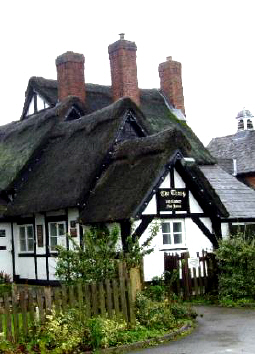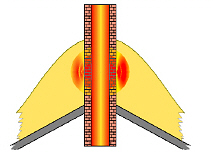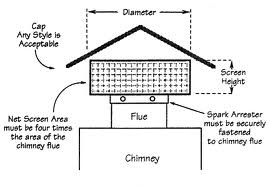

|
|
|
|
THATCHED ROOFS  A wonderful feature of many traditional homes in Britain, Ireland and elsewhere is traditional roofing of natural thatch. A home with a thatched roof is no more likely to catch fire than any other, but thatch fires can be much more destructive. Thatch fires are commonly associated with the use of solid fuel appliances, but there is a divergence of opinion on how the fires are caused, and how best to prevent them...
1: STRAY SPARKS It is commonly assumed that stray sparks from chimneys, or from nearby bonfires etc, are the commonest cause of thatch fires. This view is strongly supported by the survey of 79 fires between 2008 and 2012 carried out by the forensic analysts Burgoyne & Co (www.burgoynes.com/fires-thatched-buildings). 2: INTERNAL HEATING  Angold, Sadd & Sanders at RHM Technology Ltd, in their report “Fire and Thatch” (Summary at www.nsmtltd.co.uk/publications/Fire.pdf) highlighted the possibility that heat transfer through the chimney structure into the thatch could cause ignition. This idea has gained widespread acceptance, but has rarely been observed in practice. Some important sources, including HETAS Ltd and some fire brigades may have given the impression that internal heating is the likeliest, or even the only, cause of thatch fires. One method proposed of reducing this internal heating risk has been to use an insulated chimney-pipe inside the existing masonry chimney with a cooling air space around it, but such an installation could reduce flue gas temperature to the point where tar formation, and subsequent dangerous chimney fires or spark ejection become more, not less, likely.
THESE RECOMMENDATIONS ARE WIDELY ACCEPTED ... Keep chimneys and flues clean and well maintained - have them swept and inspected at least once a year. Do not build, rebuild or design chimneys, which pass close to or through thatch without expert advice. Thatched properties should have tall chimneys, with an absolute minimum of 1.8 metres between the top of the chimney pot and any thatch If burning wood, make very sure it has been dried out to less than about 20% moisture. Never burn dusty materials, paper or sawdust - they form stray sparks very easily. Insulate the chimney flue to prevent heat transfer and to keep the flue gases very hot. Take great care not to 'overfire' a stove. THESE MAY NEED MORE INVESTIGATION ... Flame-Retardant Coatings such as 'supercote' Under-Thatch Fire Barriers Fire-resistant materials placed on the rafters, under the thatch, such as 'Thatch Safe' or 'Thatchbatts' Mesh Netting fitted over the top of thatch Alternative Reed Materials such as 'Cape Reed' Synthetic Thatch such as 'Lapa Endureed' Spark Arrestors  A mesh guard on the chimney top can reduce the risk from stray sparks, but there is a risk that mesh may become blocked with tarry deposits which may themselves ignite and so spark arrestors are not generally recommended. However, California appears to have succeeded in reducing the incidence of fires on its many tar-shingle roofed homes using a very specific type of spark arrestor outlined in California Building Code s3102.3.8 and explained here, but it is not at all clear if this is transferable to practice in Britain and Ireland. A mesh guard on the chimney top can reduce the risk from stray sparks, but there is a risk that mesh may become blocked with tarry deposits which may themselves ignite and so spark arrestors are not generally recommended. However, California appears to have succeeded in reducing the incidence of fires on its many tar-shingle roofed homes using a very specific type of spark arrestor outlined in California Building Code s3102.3.8 and explained here, but it is not at all clear if this is transferable to practice in Britain and Ireland.
Burgoyne Report on fires in thatched buildings http://www.burgoynes.com/fires-thatched-buildings) Fire advice from the National Society of master Thatchers http://www.nsmtltd.co.uk/publications/Fire.pdf THATCHING EXPERTISE National Society of Master Thatchers www.nsmtltd.co.uk Devon County Council advice leaflet at http://www.devon.gov.uk/thatching.pdf Dorset Fire & Rescue Service - www.dorsetfire.co.uk Playle-Russell (Special Risks) Ltd, Insurance www.thatchline.com Towergate Thatched Property Insurance https://www.towergateinsurance.co.uk CHIMNEY EXPERTISE Guild Of Master Sweeps http://guildofmasterchimneysweeps.co.uk National Association Of Chimney Engineers www.nace.org.uk British Flue & Chimney Manufacturers Association www.feta.co.uk/bfcma Association of Professional & Independent Chimney Sweeps: http://www.apics.org.uk/ National Association of Chimney Sweeps www.chimneyworks.co.uk |
|
MORE FROM Soliftec... Home ● Fuel Costs ● Installation ● Library ● About ● Air Supply ● Blogspot ● Building Rules ● Carbon Monoxide ● CE Marking ● Dictionary ● Efficiency ● Electricity - CHP ● Embodied Energy ● Fascinating Facts ● Fireplace Doctor ● Fuel Properties ● Heat Need ● Heroes ● Legislation ● Manufacturers ● Open Fires ● Smoke ● Solid Fuels ● Standards ● Statistics ● Stove History ● Tables, Data and Formulas ● Test Laboratories ● Thatched Roofs ● The Carbon Cycle ● The Chimney Effect ● Wood Fuel ● Email: info@soliftec.com COPYRIGHT and ALL RIGHTS RESERVED: © Soliftec Ltd, Thursday 19 December 2019 BUILT WITH WHIMBERRY matrixstats |